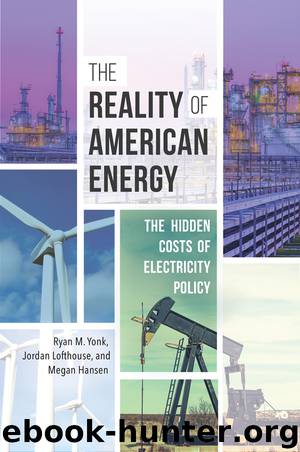The Reality of American Energy: The Hidden Costs of Electricity Policy by Ryan Yonk Jordan Lofthouse Megan Hansen

Author:Ryan Yonk,Jordan Lofthouse,Megan Hansen [Неизв.]
Language: eng
Format: epub
Publisher: ABC-CLIO
Attempts to Fix the Regulatory Burden
It is not difficult to see that the hydropower licensing process is complicated and costly. It is also easy to see that not all hydropower is the same. Most laws and regulations do not distinguish between a Hoover Dam–size hydroelectric facility and a small turbine on a municipal water pipe. Officials in the Department of Energy and members of Congress have spoken out about the potential economic and environmental benefits of increasing the use of small-scale hydropower. Despite the lip service, over 50,000 non-powered dams and countless conduits are not electrified because prospective developers avoid the expensive regulatory barriers.
In 2013, Congress attempted to tackle this burdensome red tape by passing two laws intended to make hydropower development less costly and more straightforward. The Hydropower Regulatory Efficiency Act of 2013 and the Bureau of Reclamation Small Conduit Hydropower Development and Rural Jobs Act were designed to simplify the regulations surrounding hydropower development. In 2013, Representative Cathy McMorris Rodgers (R-WA) introduced the Hydropower Regulatory Efficiency Act (HREA) to boost hydropower in her home state of Washington, which is already heavily reliant on hydropower.54 Washington is home to the Grand Coulee Dam, which is the largest hydroelectric power plant in the country. The state generates 58.4 percent of its electricity from a combination of large and small dams.55 McMorris Rodgers’s bill passed through both the House and Senate with little opposition. President Obama signed the HREA into law in August 2013.
The HREA exempts conduit-based hydropower plants that produce 5 megawatts or less from FERC licensing requirements, excluding those on federal lands.56 Developers who want to build small-scale conduit-based hydropower only have to file intent with FERC. If FERC officials decide that a project qualifies for the license waiver and no formal opposition occurs within 45 days of the waiver being granted, then the project can move forward.
The HREA also allows FERC to exempt nonconduit small-scale hydropower with outputs of 10 megawatts or less. The HREA does not exempt developers from licensing requirements, but it does make the licensing process shorter and less rigorous, and exemptions do not expire.
The HREA also allows FERC to issue permit extensions for potential license applicants. Before the law was passed, permits only lasted three years, but now FERC can extend the length of the permit for two more years. These permit extensions were meant to help developers to more accurately survey sites and determine the costs of prospective projects.
Although the intentions of the HREA are noble, the legislation has done little to promote hydropower’s growth. As of June 2015, only 58 small hydropower conduit-based projects have applied for the FERC licensing exemption, and from those applications, 43 were approved, 8 were rejected, and 7 were still pending. FERC received 30 applications for the two-year extension of preliminary permits and has granted 15 permit extensions, denied 14 for “lack of diligence,” and 1 was still pending.57 FERC’s Robert Bell oversees conduit exemptions and claims that there was an average of 10 requests per year for conduit exemptions before the HREA.
Download
This site does not store any files on its server. We only index and link to content provided by other sites. Please contact the content providers to delete copyright contents if any and email us, we'll remove relevant links or contents immediately.
The Secret History by Donna Tartt(18849)
The Social Justice Warrior Handbook by Lisa De Pasquale(12142)
Thirteen Reasons Why by Jay Asher(8796)
This Is How You Lose Her by Junot Diaz(6794)
Weapons of Math Destruction by Cathy O'Neil(6146)
Zero to One by Peter Thiel(5686)
Beartown by Fredrik Backman(5599)
The Myth of the Strong Leader by Archie Brown(5425)
The Fire Next Time by James Baldwin(5249)
How Democracies Die by Steven Levitsky & Daniel Ziblatt(5128)
Promise Me, Dad by Joe Biden(5087)
Stone's Rules by Roger Stone(5026)
A Higher Loyalty: Truth, Lies, and Leadership by James Comey(4845)
100 Deadly Skills by Clint Emerson(4840)
Rise and Kill First by Ronen Bergman(4704)
Secrecy World by Jake Bernstein(4646)
The David Icke Guide to the Global Conspiracy (and how to end it) by David Icke(4625)
The Farm by Tom Rob Smith(4438)
The Doomsday Machine by Daniel Ellsberg(4416)
